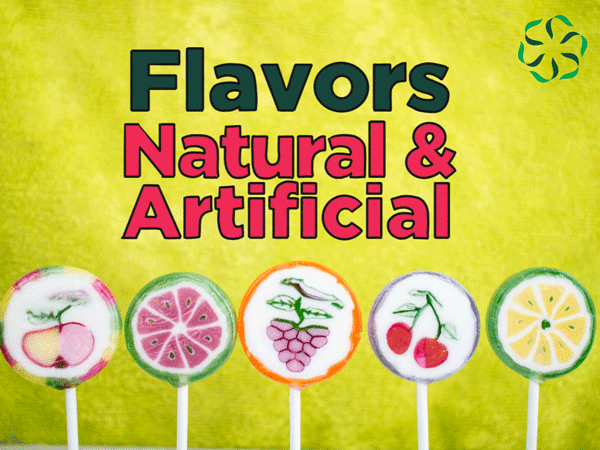What is flavor? In this series, we will explore different sources of flavors. In this post, we explore natural & artificial flavors.
How are flavors created?
As we’ve covered in a prior post, everything is made up of chemicals. Flavors are no different. A flavorist, someone whose job is to create flavors, uses chemistry to create, or recreate, familiar flavors, such as grape, vanilla, and more.
What is the difference between natural and artificial flavors?
Natural Flavor: Natural flavors are created using ingredients from natural sources such as essential oils, extracts, etc. that are derived from spices, fruits, vegetables, barks, and other natural sources. You can read the full definition of natural flavor on the U.S. FDA’s website.
Artificial Flavor: Artificial or synthetic flavorings are created from chemical sources rather than natural sources.
How are natural flavors created?
Natural flavors are developed by isolating specific chemical ingredients from natural sources, such as an essential oil from a specific fruit. A flavorist will then use chemical ingredients from a single or many natural sources to develop the flavor profile for a specific product.
Often, flavors are a combination of many different natural ingredients.
How are artificial flavors created?
A flavorist will look at the chemical composition of natural ingredients, like the vanilla bean, then create flavor profiles using one or more synthetic ingredients that align with the known chemical composition.
The completed flavor is then added to our foods and beverages in approved quantities.
Why use artificial flavors?
In some cases, artificial flavors can be created at a lower cost with greater purity and flavor consistency from artificial sources than from natural sources.
This occurs because natural flavors are derived from natural sources, meaning a crop quality can vary, the purity of the product can vary due to location and harvesting, and other factors that are out of human control can impact the availability and quality of naturally-sourced ingredients.
Are natural and artificial flavors used together?
At times a product may contain both natural and artificial flavors. A product can even include both natural and artificial flavorings of the same flavor; for example, a yogurt could use both natural and artificial strawberry flavors to provide the flavor consumers expect.
Are natural and artificial flavors safe?
Unless you have an allergy to a specific ingredient, natural and artificial flavors are safe for consumption at intended levels.
As with all ingredients, sometimes researchers discover new information that changes the safety status of an ingredient. For example, in 2018, research showed if 6 specific synthetically-derived flavoring ingredients were consumed at levels well above intended and/or typical use, they could cause harm in lab animals.
While these synthetic flavorings did not show harm to human health when used as intended in any scientific analysis, the U.S. FDA changed the safety status of those artificial flavoring ingredients, thus banning them from consumable products. However, the natural counterparts of the banned synthetic flavors are still available in foods as long as the flavor is created from naturally occurring sources rather than synthetic sources.

